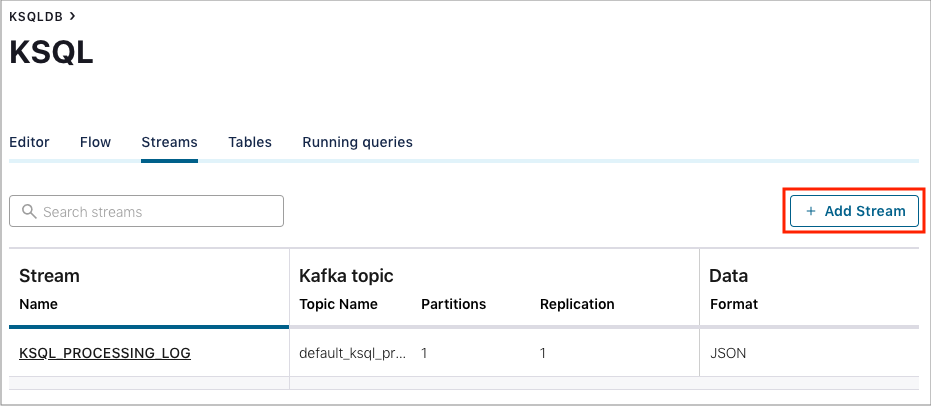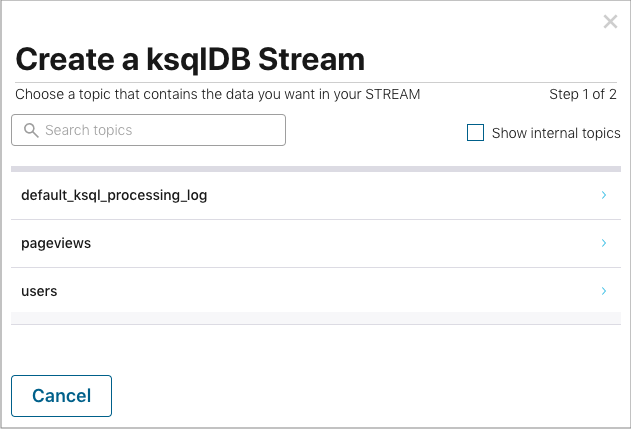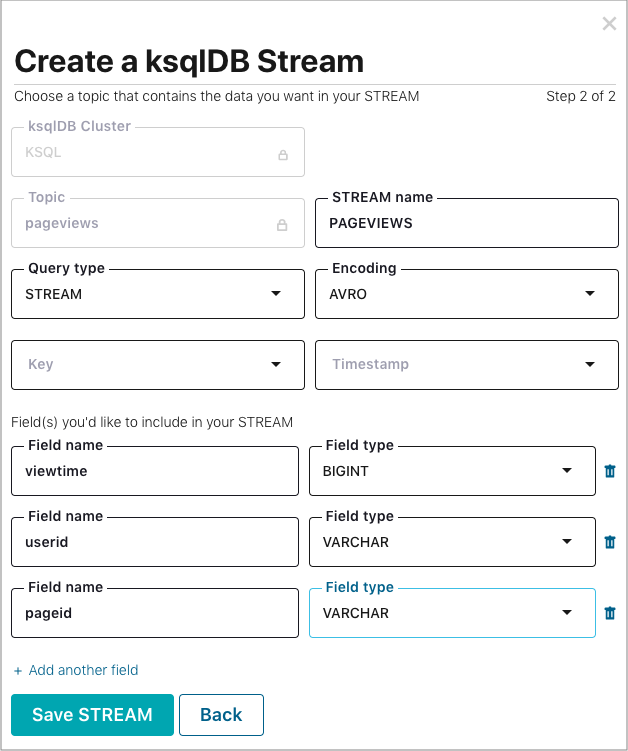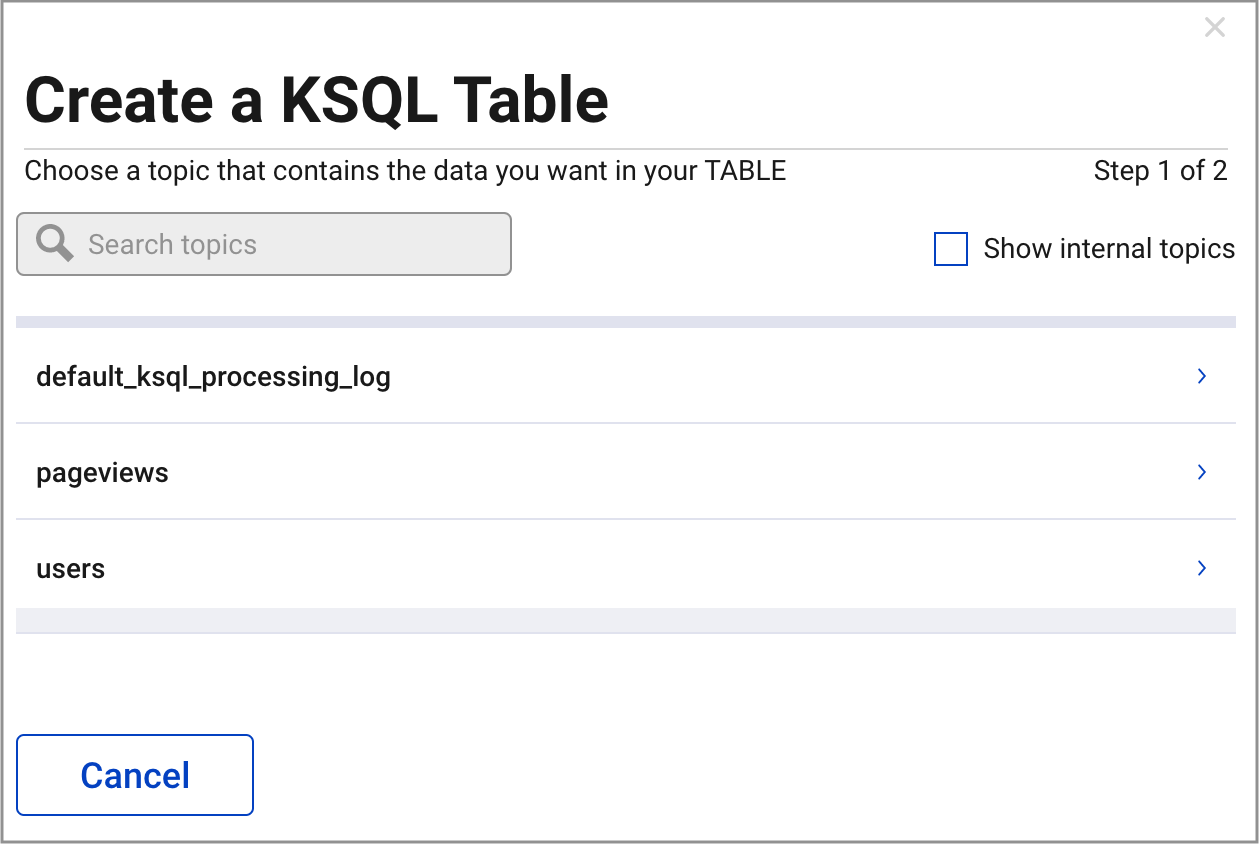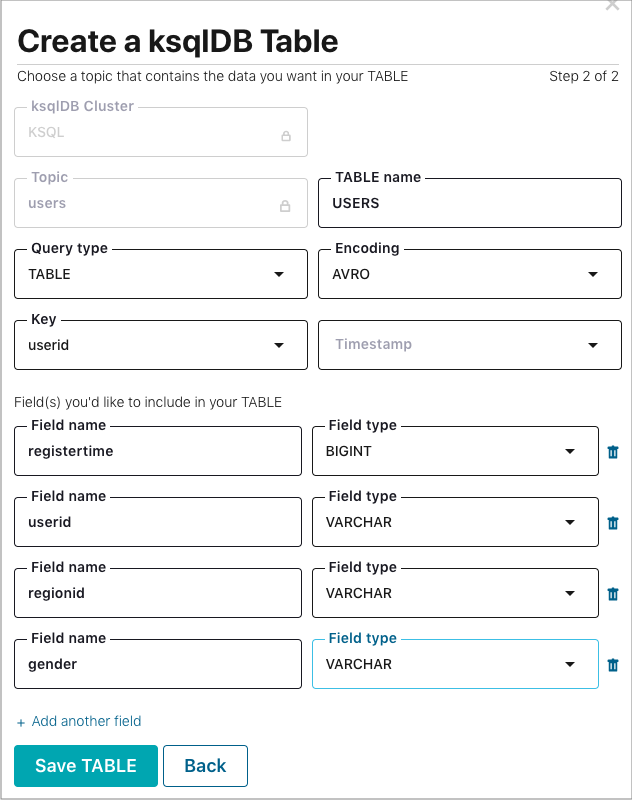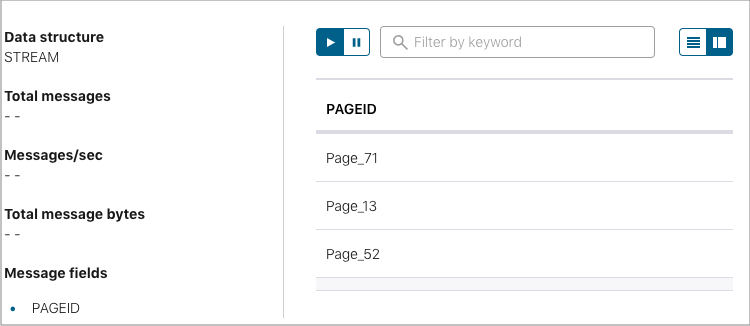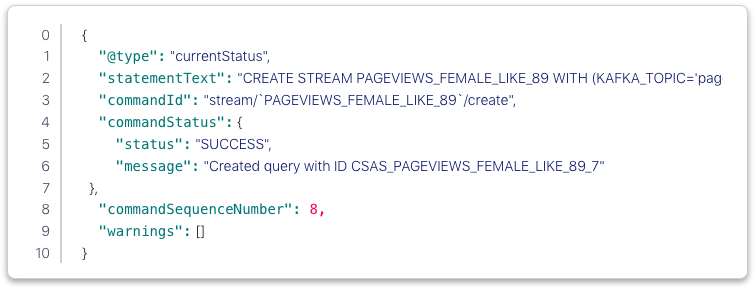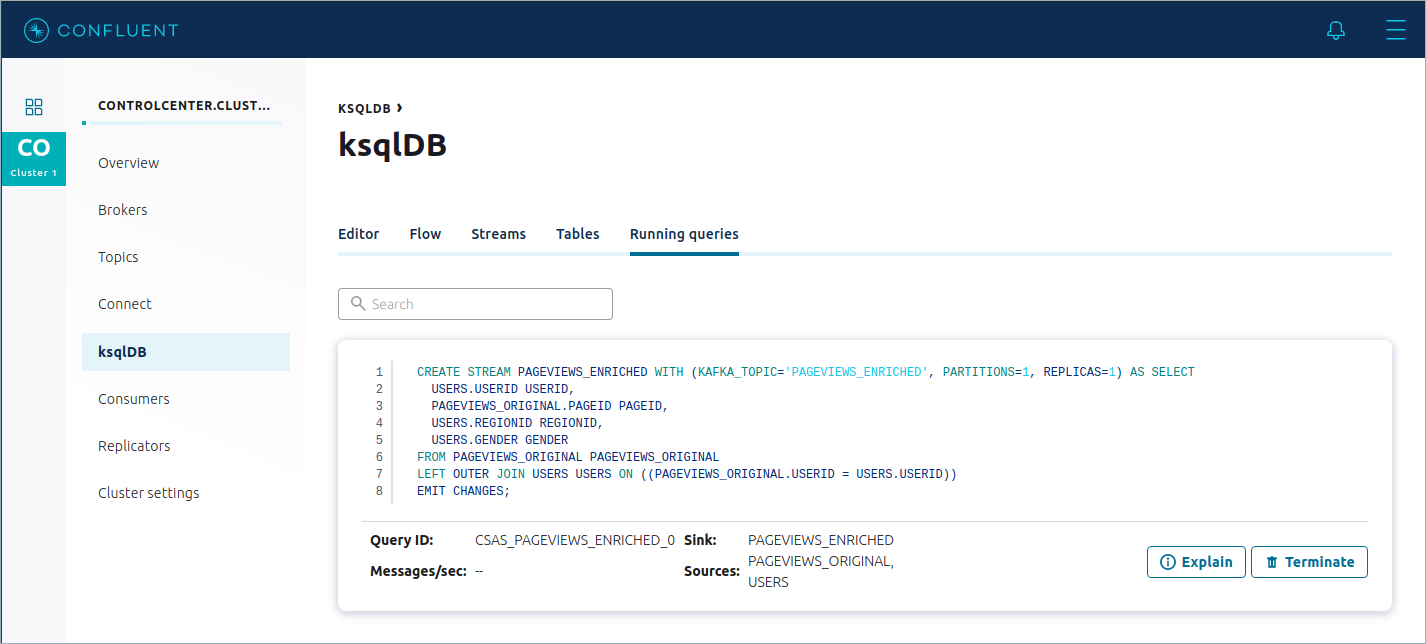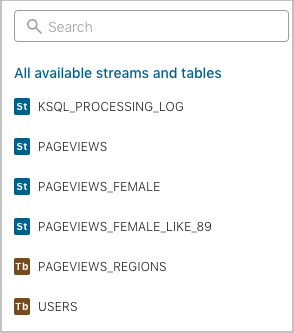Important
You are viewing documentation for an older version of Confluent Platform. For the latest, click here.
Quick Start for Apache Kafka using Confluent Platform (Docker)¶
This quick start shows you how to get up and running with Confluent Platform and its main components using Docker containers. This quick start demonstrates both the basic and most powerful capabilities of Confluent Platform, including using Control Center for topic management and event stream processing using ksqlDB. In this quick start, you create Apache Kafka® topics, use Kafka Connect to generate mock data to those topics, and create ksqlDB streaming queries on those topics. You then go to Control Center to monitor and analyze the event streaming queries.
See also
You can also run an automated version of this quick start designed for Confluent Platform local installs.
- Prerequisites:
- Docker:
- Docker version 1.11 or later is installed and running.
- Docker Compose is installed. Docker Compose is installed by default with Docker for Mac.
- Docker memory is allocated minimally at 8 GB. When using Docker Desktop for Mac, the default Docker memory allocation is 2 GB. You can change the default allocation to 8 GB in Docker > Preferences > Advanced.
- Git.
- Internet connectivity.
- Ensure you are on an Operating System currently supported by Confluent Platform.
- Networking and Kafka on Docker: Configure your hosts and ports to allow both internal and external components to the Docker network to communicate. For more details, see this article.
- Docker:
Step 1: Download and Start Confluent Platform Using Docker¶
Clone the confluentinc/cp-all-in-one GitHub repository and check out the
5.5.15-postbranch.git clone https://github.com/confluentinc/cp-all-in-one cd cp-all-in-one git checkout 5.5.15-post
Navigate to
/cp-all-in-one/cp-all-in-onedirectory.cd cp-all-in-one/
Start Confluent Platform specifying the
-doption to run in detached mode.Important
You must allocate a minimum of 8 GB of Docker memory resource. The default memory allocation on Docker Desktop for Mac is 2 GB and must be changed.
docker-compose up -d
This starts Confluent Platform with separate containers for all Confluent Platform components. Your output should resemble the following:
Creating network "cp-all-in-one_default" with the default driver Creating zookeeper ... done Creating broker ... done Creating schema-registry ... done Creating rest-proxy ... done Creating connect ... done Creating ksql-datagen ... done Creating ksqldb-server ... done Creating control-center ... done Creating ksqldb-cli ... done
Optional: Run this command to verify that the services are up and running.
docker-compose psYou should see the following:
Name Command State Ports ------------------------------------------------------------------------------------------ broker /etc/confluent/docker/run Up 0.0.0.0:29092->29092/tcp, 0.0.0.0:9092->9092/tcp connect /etc/confluent/docker/run Up 0.0.0.0:8083->8083/tcp, 9092/tcp control-center /etc/confluent/docker/run Up 0.0.0.0:9021->9021/tcp ksqldb-cli ksql http://localhost:8088 Up ksqldb-datagen bash -c echo Waiting for K ... Up ksqldb-server /etc/confluent/docker/run Up 0.0.0.0:8088->8088/tcp rest-proxy /etc/confluent/docker/run Up 0.0.0.0:8082->8082/tcp schema-registry /etc/confluent/docker/run Up 0.0.0.0:8081->8081/tcp zookeeper /etc/confluent/docker/run Up 0.0.0.0:2181->2181/tcp, 2888/tcp, 3888/tcp
If the state is not
Up, rerun thedocker-compose up -dcommand.
Step 2: Create Kafka Topics¶
In this step, you create Kafka topics by using Confluent Control Center. Confluent Control Center provides the functionality for building and monitoring production data pipelines and event streaming applications.
Navigate to the Control Center web interface at http://localhost:9021/ and select your cluster.
Important
It may take a minute or two for Control Center to come online.
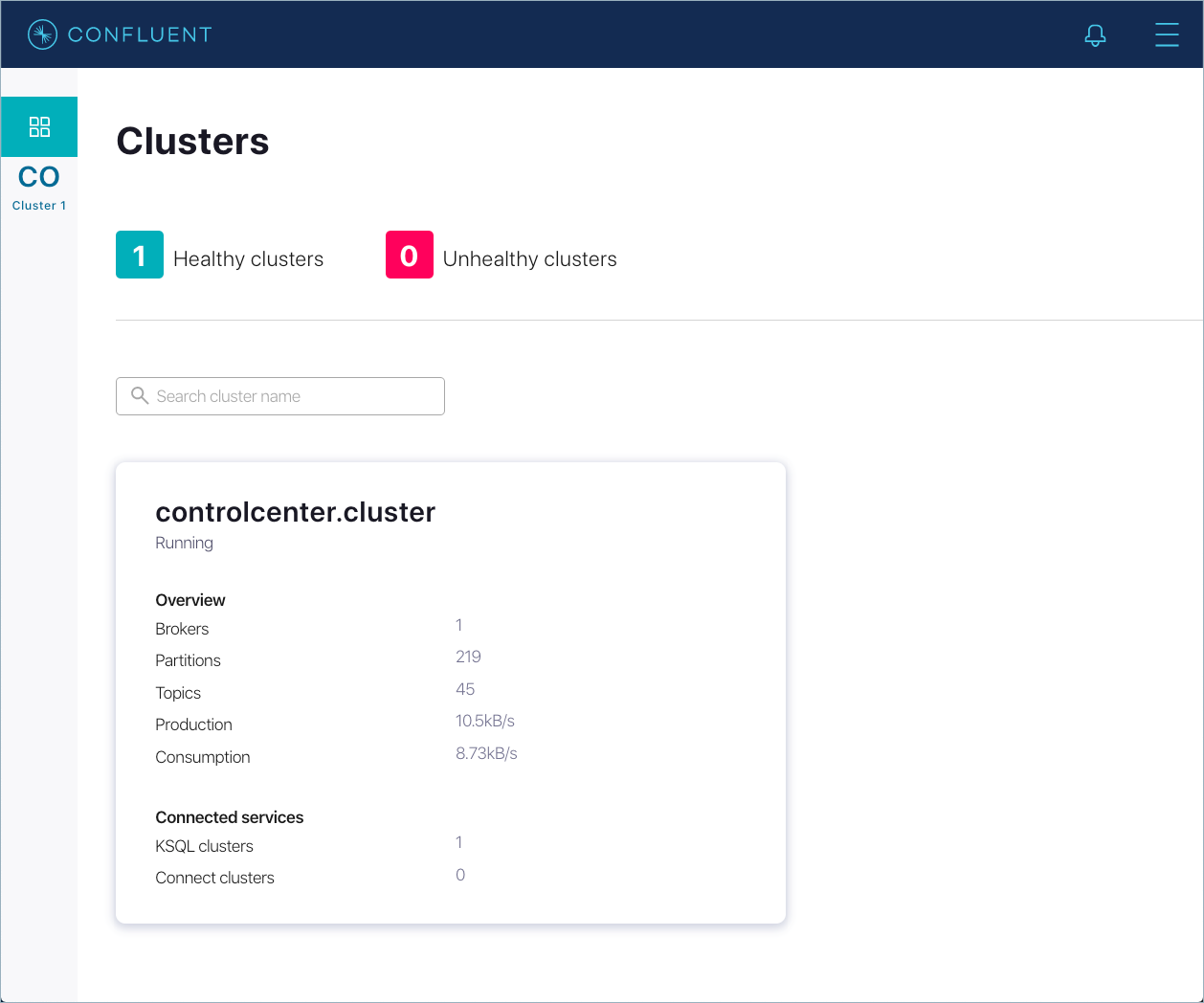
Select Topics from the cluster submenu and click Add a topic.
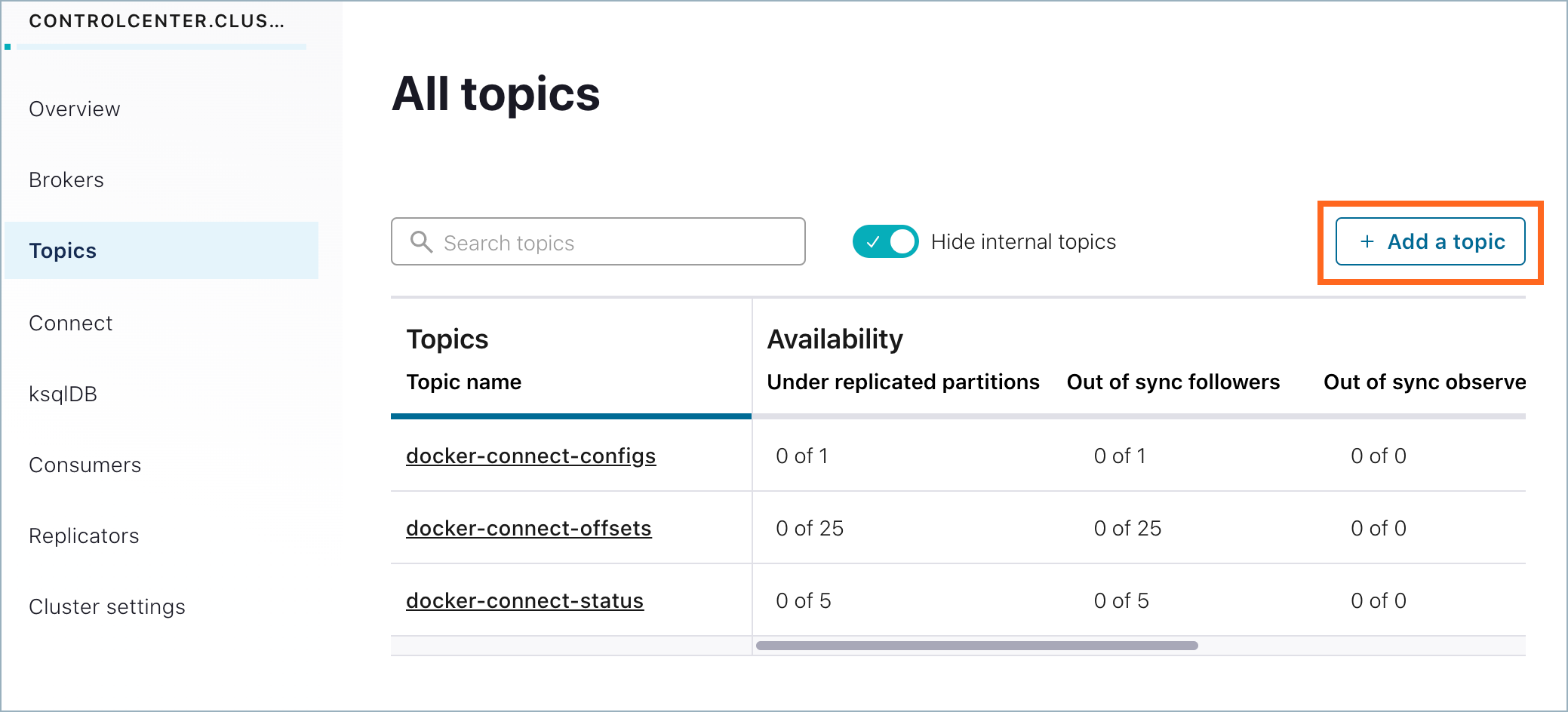
Create a topic named
pageviewsand click Create with defaults.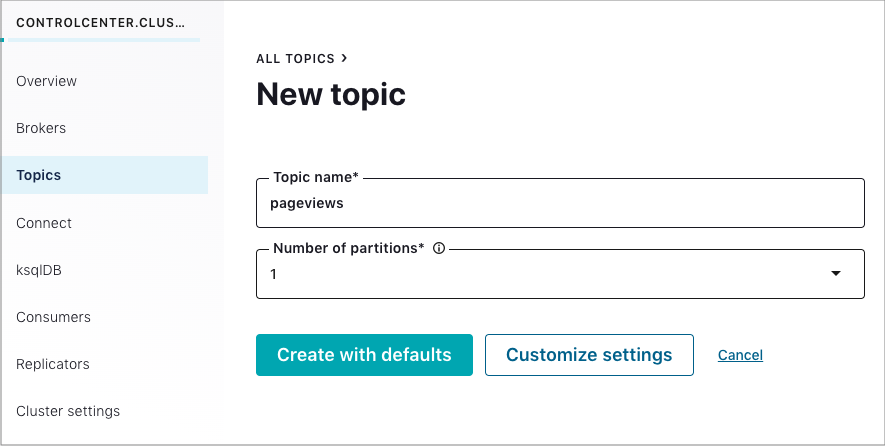
Repeat the previous steps and create a topic named
usersand click Create with defaults.
Step 3: Install a Kafka Connector and Generate Sample Data¶
In this step, you use Kafka Connect to run a demo source connector called kafka-connect-datagen that creates sample data for the Kafka topics pageviews and users.
Tip
The Kafka Connect Datagen connector was installed automatically when you started Docker Compose in Step 1: Download and Start Confluent Platform Using Docker. If you encounter issues locating the Datagen Connector, refer to the Issue: Cannot locate the Datagen Connector in the Troubleshooting section.
Run one instance of the Kafka Connect Datagen connector to produce Kafka data to the
pageviewstopic in AVRO format.From your cluster, click Connect.
Select the
connect-defaultcluster and click Add connector.Find the DatagenConnector tile and click Connect.
Tip
To narrow displayed connectors, click Filter by type -> Sources.
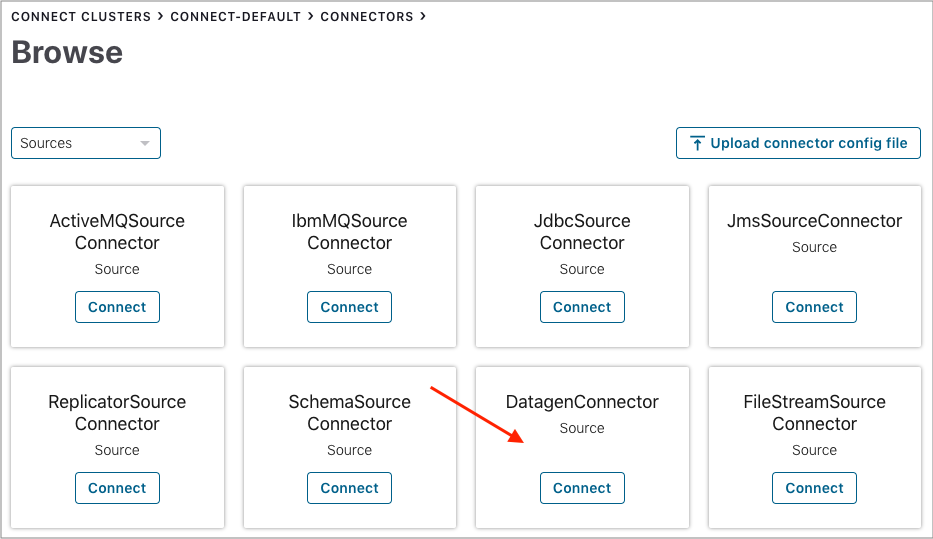
Name the connector
datagen-pageviews. After naming the connector, new fields appear. Scroll down and specify the following configuration values:- In the Key converter class field, type
org.apache.kafka.connect.storage.StringConverter. - In the kafka.topic field, type
pageviews. - In the max.interval field, type
100. - In the quickstart field, type
pageviews.

- In the Key converter class field, type
Click Continue.
Review the connector configuration and click Launch.

Run another instance of the Kafka Connect Datagen connector to produce Kafka data to the
userstopic in AVRO format.- Select the
connect_defaultcluster and click Add connector. - Find the DatagenConnector tile and click Connect.
- Name the connector
datagen-users. After naming the connector, new fields appear. Scroll down and specify the following configuration values:- In the Key converter class field, type
org.apache.kafka.connect.storage.StringConverter. - In the kafka.topic field, type
users. - In the max.interval field, type
1000. - In the quickstart field, type
users.
- In the Key converter class field, type
- Click Continue.
- Review the connector configuration and click Launch.
- Select the
Step 4: Create and Write to a Stream and Table using ksqlDB¶
In this step, SQL queries are run on the pageviews and users topics that were created in the previous step. The
ksqlDB commands are run using the ksqlDB tab in Control Center.
Tip
You can also run these commands using the ksqlDB CLI from your Docker container
with this command: docker-compose exec ksqldb-cli ksql http://ksqldb-server:8088.
Create Streams and Tables¶
In this step, ksqlDB is used to create a stream for the pageviews topic, and a table for the users topic.
From your cluster, click ksqlDB and choose the ksqlDB application.
From the ksqlDB EDITOR page, click the Streams tab and Add Stream.
Select the
pageviewstopic.Choose your stream options:
- In the Encoding field, select
AVRO. - In the Field(s) you’d like to include in your STREAM field, ensure fields are set as follows:
viewtimewith typeBIGINTuseridwith typeVARCHARpageidwith typeVARCHAR
- In the Encoding field, select
Click Save STREAM.
Click the Tables tab -> Add a Table and select the
userstopic.Choose your table options:
- In the Encoding field, select
AVRO. - In the Key field, select
userid. - In the Field(s) you’d like to include in your TABLE field, ensure fields are set as follows:
registertimewith typeBIGINTuseridwith typeVARCHARregionidwith typeVARCHARgenderwith typeVARCHAR
- In the Encoding field, select
Click Save TABLE.
Write Queries¶
These examples write queries using the ksqlDB tab in Control Center.
From your cluster, click ksqlDB and choose the Editor page.
From the ksqlDB EDITOR page, click Add query properties to add a custom query property. Set the
auto.offset.resetparameter toearliest.This instructs ksqlDB queries to read all available topic data from the beginning. This configuration is used for each subsequent query. For more information, see the ksqlDB Configuration Parameter Reference.
Run the following queries.
Create a non-persistent query that returns data from a stream with the results limited to a maximum of three rows.
SELECT pageid FROM pageviews EMIT CHANGES LIMIT 3;
Your output should resemble:
Tip
Click the Card view or Tabular view icon to change the layout. Click the expand icon to expand a message.
Create a persistent query that filters for female users. The results from this query are written to the Kafka
PAGEVIEWS_FEMALEtopic. This query enriches thepageviewsSTREAM by doing aLEFT JOINwith theusersTABLE on the user ID, where a condition (gender = 'FEMALE') is met.CREATE STREAM pageviews_female AS SELECT users.userid AS userid, pageid, regionid, gender FROM pageviews LEFT JOIN users ON pageviews.userid = users.userid WHERE gender = 'FEMALE';
Your output should resemble:
Create a persistent query where a condition (
regionid) is met, usingLIKE. Results from this query are written to a Kafka topic namedpageviews_enriched_r8_r9.CREATE STREAM pageviews_female_like_89 WITH (kafka_topic='pageviews_enriched_r8_r9', value_format='AVRO') AS SELECT * FROM pageviews_female WHERE regionid LIKE '%_8' OR regionid LIKE '%_9';Your output should resemble:
Create a persistent query that counts the pageviews for each region and gender combination in a tumbling window of 30 seconds when the count is greater than 1. Because the procedure is grouping and counting, the result is now a table, rather than a stream. Results from this query are written to a Kafka topic called
PAGEVIEWS_REGIONS.CREATE TABLE pageviews_regions AS SELECT gender, regionid , COUNT(*) AS numusers FROM pageviews_female WINDOW TUMBLING (size 30 second) GROUP BY gender, regionid HAVING COUNT(*) > 1;
Your output should resemble:
Click Running queries. You should see the following persisted queries:
Click Editor. On the right side of the page, find the All available streams and tables pane, which shows all of the streams and tables that you can access.
In the All available streams and tables section, click KSQL_PROCESSING_LOG to view the stream’s schema, including nested data structures.
Step 5: Monitor Consumer Lag¶
Navigate to the Consumers tab to view the consumers created by ksqlDB.
Click the consumer group ID to view details for the _confluent-ksql-default_query_CSAS_PAGEVIEWS_FEMALE consumer group.
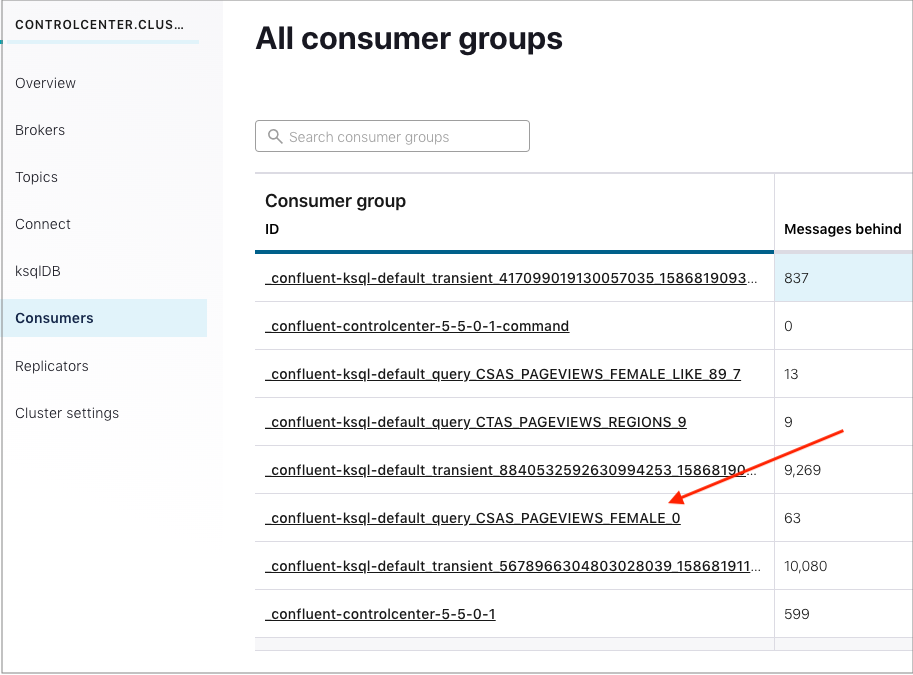
From this page you can see the consumer lag and consumption values for your streaming query.
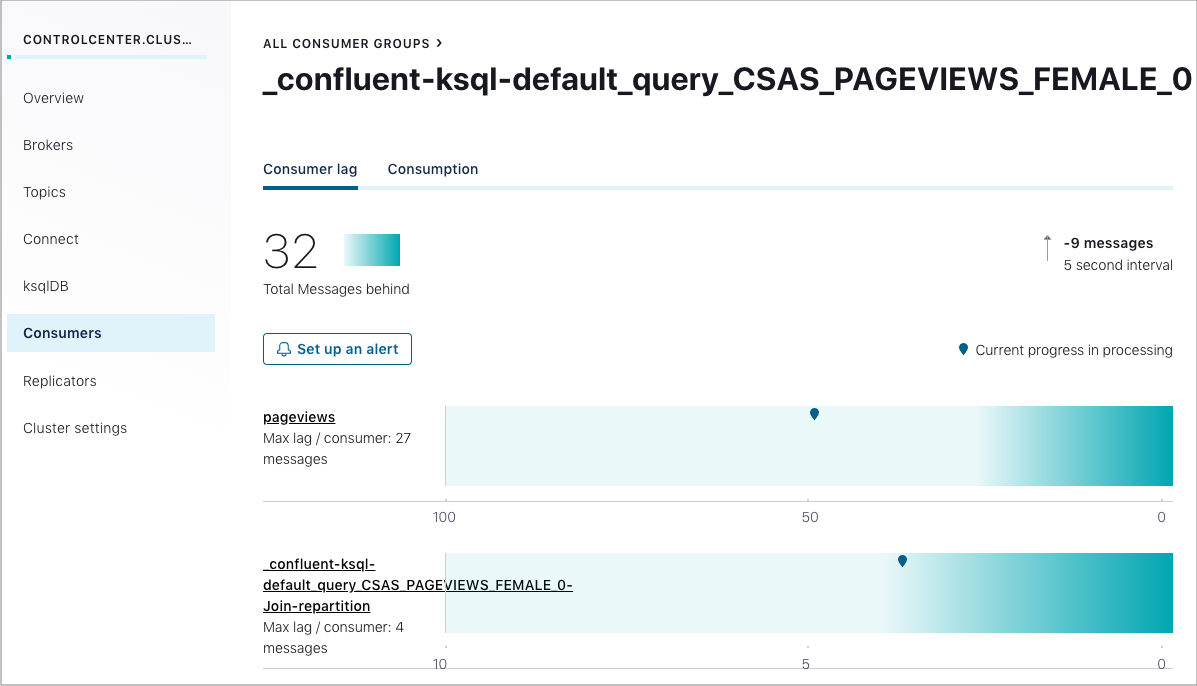
For more information, see the Control Center Consumers documentation.
Step 6: Stop Docker¶
When you are done working with Docker, you can stop and remove Docker containers and images.
View a list of all Docker container IDs.
docker container ls -aq
Run the following command to stop the Docker containers for Confluent:
docker container stop $(docker container ls -a -q -f "label=io.confluent.docker")
Run the following commands to stop the containers and prune the Docker system. Running these commands deletes containers, networks, volumes, and images; freeing up disk space:
docker container stop $(docker container ls -a -q -f "label=io.confluent.docker") && docker system prune -a -f --volumes
Tip
Remove the filter label for Confluent Docker (
-f "label=io.confluent.docker") to clear all Docker containers from your system.
You can rebuild and restart the containers at any time using the docker-compose up -d command.
For more information, refer to the official Docker documentation.
Troubleshooting¶
If you encountered any issues, review the following resolutions before trying the steps again.
Issue: Cannot locate the Datagen Connector¶
For details, see Step 1: Download and Start Confluent Platform Using Docker.
Resolution: Run the build command just for connect.
docker-compose build --no-cache connect
Your output should resemble:
Building connect
...
Completed
Removing intermediate container cdb0af3550c8
---> 36d00047d29b
Successfully built 36d00047d29b
Successfully tagged confluentinc/kafka-connect-datagen:latest
Resolution: Check the Connect log for Datagen.
docker-compose logs connect | grep -i Datagen
Your output should resemble:
connect | [2019-04-17 20:03:26,137] INFO Loading plugin from: /usr/share/confluent-hub-components/confluentinc-kafka-connect-datagen (org.apache.kafka.connect.runtime.isolation.DelegatingClassLoader)
connect | [2019-04-17 20:03:26,206] INFO Registered loader: PluginClassLoader{pluginLocation=file:/usr/share/confluent-hub-components/confluentinc-kafka-connect-datagen/} (org.apache.kafka.connect.runtime.isolation.DelegatingClassLoader)
connect | [2019-04-17 20:03:26,206] INFO Added plugin 'io.confluent.kafka.connect.datagen.DatagenConnector' (org.apache.kafka.connect.runtime.isolation.DelegatingClassLoader)
connect | [2019-04-17 20:03:28,102] INFO Added aliases 'DatagenConnector' and 'Datagen' to plugin 'io.confluent.kafka.connect.datagen.DatagenConnector' (org.apache.kafka.connect.runtime.isolation.DelegatingClassLoader)
Resolution: Check the Connect log for a warning and reminder to run the docker-compose up -d command properly.
docker-compose logs connect | grep -i Datagen
Resolution: Verify the .jar file for kafka-connect-datagen has been added and is present in the lib subfolder.
docker-compose exec connect ls /usr/share/confluent-hub-components/confluentinc-kafka-connect-datagen/lib/
Your output should resemble:
...
kafka-connect-datagen-0.1.0.jar
...
Resolution: Verify the plugin exists in the connector path.
docker-compose exec connect bash -c 'echo $CONNECT_PLUGIN_PATH'
Your output should resemble:
/usr/share/java,/usr/share/confluent-hub-components
Confirm its contents are present:
docker-compose exec connect ls /usr/share/confluent-hub-components/confluentinc-kafka-connect-datagen
Your output should resemble:
assets doc etc lib manifest.json
Resolution: In Kafka Connect > Setup Connection, scroll down through the list of connectors to locate DatagenConnector; there are multiple connectors in the menu.
Issue: Stream-Stream joins error¶
An error states Stream-Stream joins must have a WITHIN clause specified. This error can occur if you created streams
for both pageviews and users by mistake.
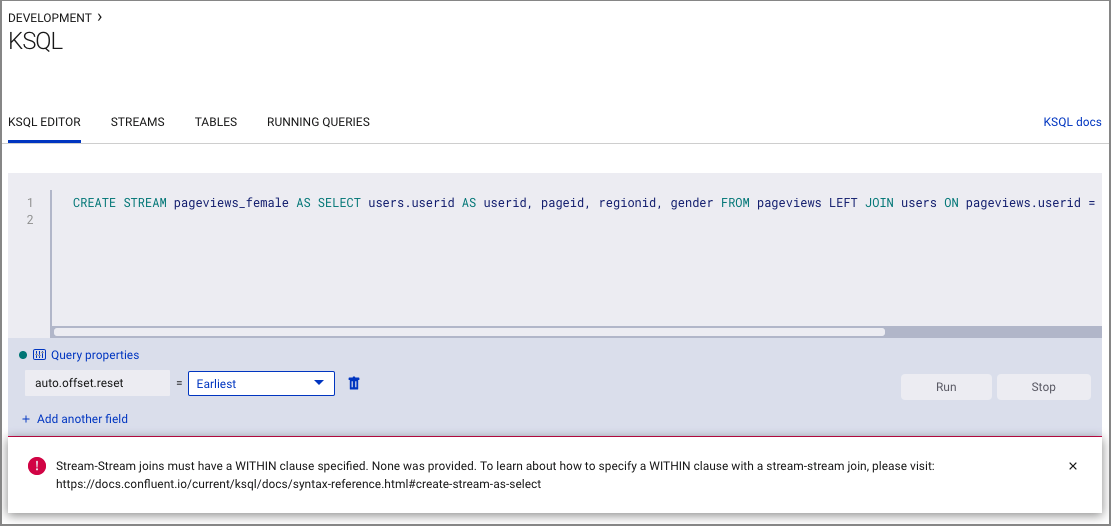
Resolution: Ensure that you created a stream for pageviews, and a table for users in Step 4: Create and Write to a Stream and Table using ksqlDB.
Issue: Unable to successfully complete ksqlDB query steps¶
Java errors or other severe errors were encountered.
Resolution: Ensure you are on an Operating System currently supported by Confluent Platform.
Resolution: Ensure that the Docker memory was increased to 8 MB. Go to Docker > Preferences > Advanced. If Docker memory is insufficient, other unpredictable issues could occur.
Next Steps¶
Learn more about the components shown in this quick start:
- ksqlDB documentation Learn about processing your data with ksqlDB for use cases such as streaming ETL, real-time monitoring, and anomaly detection. You can also learn how to use ksqlDB with this collection of scripted demos.
- Kafka Tutorials Try out basic Kafka, Kafka Streams, and ksqlDB tutorials with step-by-step instructions.
- Kafka Streams documentation Learn how to build stream processing applications in Java or Scala.
- Kafka Connect documentation Learn how to integrate Kafka with other systems and download ready-to-use connectors to easily ingest data in and out of Kafka in real-time.
- Kafka Clients documentation Learn how to read and write data to and from Kafka using programming languages such as Go, Python, .NET, C/C++.
- Videos, Demos, and Reading Material Try out the Confluent Platform tutorials and examples, watch demos and screencasts, and learn with white papers and blogs.

